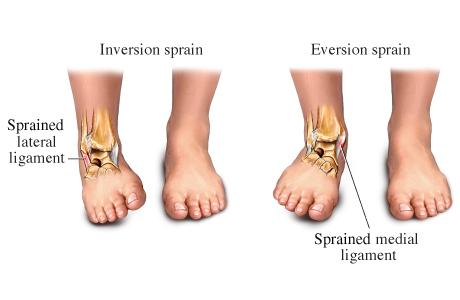Sprained Ankle Q & A
What’s the difference between a sprained, strained, and broken ankle?
When you roll your ankle, you may not be able to identify if it’s sprained, strained, or broken, but you may be able to take an educated guess. The only way to get an accurate diagnosis is to see a doctor.
Sprain
A sprain is a stretched, partially torn, or torn ligament. This injury can cause the ankle joint to become loose. A sprain usually causes pain, swelling, and bruising.
Strain
A strain is when you twist, pull, or tear a muscle or tendon from overuse or inadequate rest. A ruptured tendon is a severe injury that requires medical attention. Swelling, muscle weakness, and cramping often accompany the pain from strains.
Broken bone
A broken ankle is a fracture or break in the bone and requires urgent medical attention, especially if the pain doesn’t go away or the bone looks deformed. Podiatrists needs to perform an X-ray to confirm the break and provide treatment to ensure proper healing.
When should I see a doctor?
If you injure your ankle during an athletic event, a work occurrence, or another accident, see Podiatrists for an evaluation as soon as you can. Even if you want to “wait it out” or your foot can’t bear weight after several days, you should see a doctor. Leave the diagnosis and treatment recommendations to a licensed professional.
How do you treat a sprained ankle?
A minor strain may need little more than rest and at-home care. More severe strains may require the following:
Immobilization with assistive devices
Rehabilitation with physical therapy
Surgery to repair torn ligaments
Podiatrists helps rehab your ankle so you can return to your favorite activities as soon as possible.
How can I prevent a sprained ankle?
If you’re active, begin each workout with a warm-up and add stretches and strength building exercises to your fitness repertoire. Building strength in your legs and ankles helps increase the supporting structures in your legs, while stretching enhances your mobility.
Wearing supportive, proper-fitting shoes is also essential. Supportive shoes help prevent your ankles from rolling.
If you think you’ve sprained your ankle, call Podiatrists’s office to discuss your next step.
